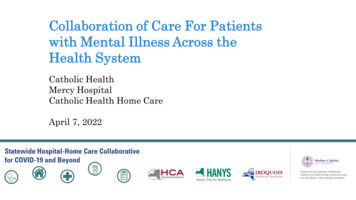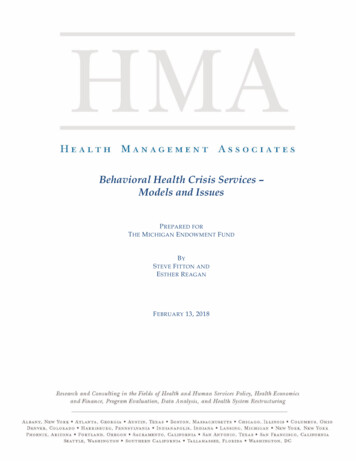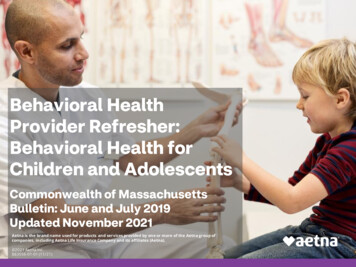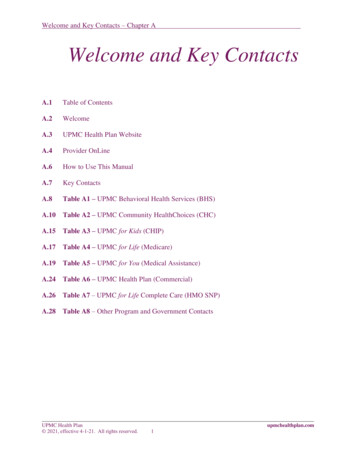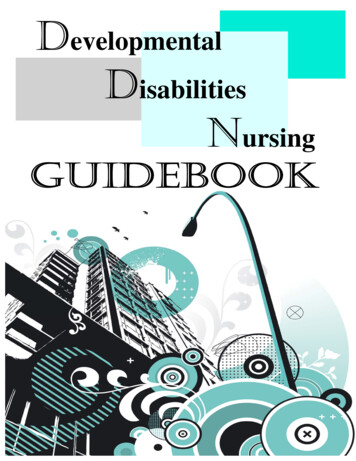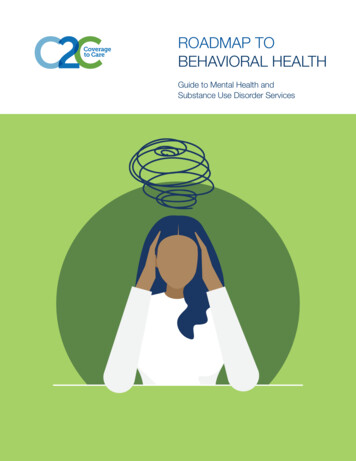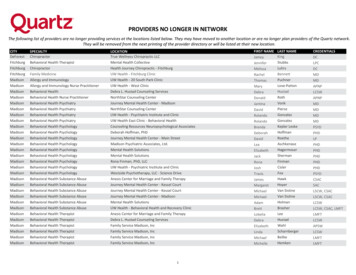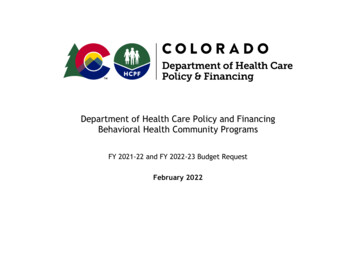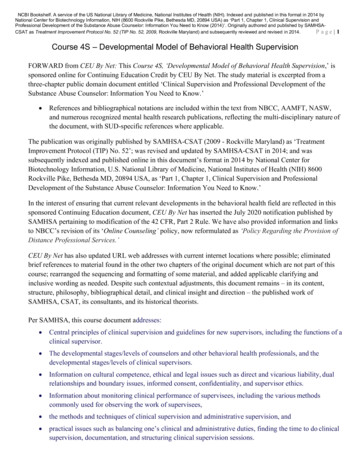
Transcription
NCBI Bookshelf. A service of the US National Library of Medicine, National Institutes of Health (NIH). Indexed and published in this format in 2014 byNational Center for Biotechnology Information, NIH (8600 Rockville Pike, Bethesda MD, 20894 USA) as ‘Part 1, Chapter 1, Clinical Supervision andProfessional Development of the Substance Abuse Counselor: Information You Need to Know (2014)’. Originally authored and published by SAMHSACSAT as Treatment Improvement Protocol No. 52 (TIP No. 52, 2009, Rockville Maryland) and subsequently reviewed and revised in 2014.P age 1Course 4S – Developmental Model of Behavioral Health SupervisionFORWARD from CEU By Net: This Course 4S, ‘Developmental Model of Behavioral Health Supervision,’ issponsored online for Continuing Education Credit by CEU By Net. The study material is excerpted from athree-chapter public domain document entitled ‘Clinical Supervision and Professional Development of theSubstance Abuse Counselor: Information You Need to Know.’ References and bibliographical notations are included within the text from NBCC, AAMFT, NASW,and numerous recognized mental health research publications, reflecting the multi-disciplinary nature ofthe document, with SUD-specific references where applicable.The publication was originally published by SAMHSA-CSAT (2009 - Rockville Maryland) as ‘TreatmentImprovement Protocol (TIP) No. 52’; was revised and updated by SAMHSA-CSAT in 2014; and wassubsequently indexed and published online in this document’s format in 2014 by National Center forBiotechnology Information, U.S. National Library of Medicine, National Institutes of Health (NIH) 8600Rockville Pike, Bethesda MD, 20894 USA, as ‘Part 1, Chapter 1, Clinical Supervision and ProfessionalDevelopment of the Substance Abuse Counselor: Information You Need to Know.’In the interest of ensuring that current relevant developments in the behavioral health field are reflected in thissponsored Continuing Education document, CEU By Net has inserted the July 2020 notification published bySAMHSA pertaining to modification of the 42 CFR, Part 2 Rule. We have also provided information and linksto NBCC’s revision of its ‘Online Counseling’ policy, now reformulated as ‘Policy Regarding the Provision ofDistance Professional Services.’CEU By Net has also updated URL web addresses with current internet locations where possible; eliminatedbrief references to material found in the other two chapters of the original document which are not part of thiscourse; rearranged the sequencing and formatting of some material, and added applicable clarifying andinclusive wording as needed. Despite such contextual adjustments, this document remains – in its content,structure, philosophy, bibliographical detail, and clinical insight and direction – the published work ofSAMHSA, CSAT, its consultants, and its historical theorists.Per SAMHSA, this course document addresses: Central principles of clinical supervision and guidelines for new supervisors, including the functions of aclinical supervisor. The developmental stages/levels of counselors and other behavioral health professionals, and thedevelopmental stages/levels of clinical supervisors. Information on cultural competence, ethical and legal issues such as direct and vicarious liability, dualrelationships and boundary issues, informed consent, confidentiality, and supervisor ethics. Information about monitoring clinical performance of supervisees, including the various methodscommonly used for observing the work of supervisees, the methods and techniques of clinical supervision and administrative supervision, and practical issues such as balancing one’s clinical and administrative duties, finding the time to do clinicalsupervision, documentation, and structuring clinical supervision sessions.
NCBI Bookshelf. A service of the US National Library of Medicine, National Institutes of Health (NIH). Indexed and published in this format in 2014 byNational Center for Biotechnology Information, NIH (8600 Rockville Pike, Bethesda MD, 20894 USA) as ‘Part 1, Chapter 1, Clinical Supervision andProfessional Development of the Substance Abuse Counselor: Information You Need to Know (2014)’. Originally authored and published by SAMHSACSAT as Treatment Improvement Protocol No. 52 (TIP No. 52, 2009, Rockville Maryland) and subsequently reviewed and revised in 2014.P age 21. Introduction to This CourseClinical supervision is emerging as the crucible in which mental health and SUD professionals acquireknowledge and skills for the behavioral health professions, providing a bridge between the classroom and theclinic. Supervision is necessary . to improve client care, develop the professionalism of clinical personnel, andimpart and maintain ethical standards in the field. In recent years . clinical supervision has become thecornerstone of quality improvement and assurance.Your role and skill set as a clinical supervisor are distinct from those of ‘counselor’ and ‘administrator.’ SeeFigure 2. Quality clinical supervision is founded on a positive supervisor–supervisee relationship thatpromotes client welfare and the professional development of the supervisee. You are a teacher, coach,consultant, mentor, evaluator, and administrator; you provide support, encouragement, and education to staffwhile addressing an array of psychological, interpersonal, physical, and spiritual issues of clients.Ultimately, effective clinical supervision ensures that clients are competently served. Supervision ensures thatsupervisees continue to increase their skills, which in turn increases treatment effectiveness, client retention,and staff satisfaction. The clinical supervisor also serves as liaison between administrative and clinical staff.Supervision . . . is a profession in its own right, with its own theories, practices, and standards. The professionrequires knowledgeable, competent, and skillful individuals who are appropriately credentialed both as acounselor/clinician/therapist/social worker and as a supervisor. This document focuses primarily on theteaching, coaching, consulting, and clinical mentoring functions of behavioral health supervisors.The central theme of the document is derived from the Integrated or Blended Developmental Stages Models forboth Supervisors and their Supervisees, articulated and published by Stoltenberg, McNeill, and Delworth (1998),Figures 3 and 4. Stoltenberg et al provide guidelines and tools for the effective delivery of clinical supervisionacross three Stages of Development for both the behavioral health Counselor/Supervisee and the Supervisor.This document also builds on and makes reference to CSAT’s Technical Assistance Publication (TAP),Competencies for Substance Abuse Treatment Clinical Supervisors (TAP 21-A; CSAT, 2007) as well as toother publications and theories pertaining to the development of supervision skills in the mental healthand addiction treatment professions.The perspective of this material is informed by the following definitions of supervision: “Supervision is a disciplined, tutorial process wherein principles are transformed into practical skills, withfour overlapping foci: administrative, evaluative, clinical, and supportive” (Powell & Brodsky, 2004). Supervision is an intervention provided by a senior member of a profession to a more junior member ormembers. “The relationship is evaluative, extends over time, and has the simultaneous purposes of enhancing theprofessional functioning of the more junior person(s); monitoring the quality of professional servicesoffered to the clients that she, he, or they see; and serving as a gatekeeper of those who are to enter theparticular profession” (Bernard & Goodyear, 2004).
NCBI Bookshelf. A service of the US National Library of Medicine, National Institutes of Health (NIH). Indexed and published in this format in 2014 byNational Center for Biotechnology Information, NIH (8600 Rockville Pike, Bethesda MD, 20894 USA) as ‘Part 1, Chapter 1, Clinical Supervision andProfessional Development of the Substance Abuse Counselor: Information You Need to Know (2014)’. Originally authored and published by SAMHSACSAT as Treatment Improvement Protocol No. 52 (TIP No. 52, 2009, Rockville Maryland) and subsequently reviewed and revised in 2014.P ag Supervision is “a social influence process that occurs over time, in which the supervisorparticipates with supervisees to ensure quality of clinical care. Effective supervisors observe, mentor, coach, evaluate, inspire, and create an atmosphere thatpromotes self-motivation, learning, and professional development. They build teams, create cohesion, resolve conflict, and shape agency culture, while attendingto ethical and diversity issues in all aspects of the process. Such supervision is key to both quality improvement and the successful implementation ofconsensus- and evidence-based practices” {CSAT, 2007).RationaleFor hundreds of years, many professions have relied on more senior colleagues to guide less experiencedprofessionals in their crafts. This is a relatively new development in the substance abuse field, as clinicalsupervision was historically not acknowledged as a discrete process with its own concepts and approaches.As indicated in the references cited within this publication, the mental health professions have historicallyrequired supervision of its professionals for obtaining and retaining licenses.As a supervisor dedicated to the client, the supervisee, and the organization, the significance of your position isapparent in the following statements: Organizations have an obligation to ensure quality care and quality improvement of all personnel.The first aim of clinical supervision is to ensure quality services and to protect the welfare ofclients. Supervision is the right of all employees and has a direct impact on workforce development andstaff and client retention. You oversee the clinical functions of staff and have a legal and ethical responsibility to ensurequality care to clients, the professional development and stability of behavioral health providers, andmaintenance of program policies and procedures. Clinical supervision is how behavioral health providers in the field learn. In concert with classroomeducation, clinical skills are acquired through practice, observation, feedback, and implementationof the recommendations derived from clinical supervision.Functions of a Clinical SupervisorYou, the clinical supervisor, wear several important “hats.” You facilitate the integration of supervisee selfawareness, theoretical grounding, and development of clinical knowledge and skills; and you improvefunctional skills and professional practices. These roles often overlap and are fluid within the context of thesupervisory relationship.e 3
NCBI Bookshelf. A service of the US National Library of Medicine, National Institutes of Health (NIH). Indexed and published in this format in 2014 byNational Center for Biotechnology Information, NIH (8600 Rockville Pike, Bethesda MD, 20894 USA) as ‘Part 1, Chapter 1, Clinical Supervision andProfessional Development of the Substance Abuse Counselor: Information You Need to Know (2014)’. Originally authored and published by SAMHSACSAT as Treatment Improvement Protocol No. 52 (TIP No. 52, 2009, Rockville Maryland) and subsequently reviewed and revised in 2014.P age 4Hence, the supervisor is in a unique position as an advocate for the agency, the supervisee, and the client.You are the primary link between administration and front line staff, interpreting and monitoring compliancewith agency goals, policies, and procedures and communicating staff and client needs to administrators.Central to the supervisor’s function is the alliance between the supervisor and supervisee. [S. RigazioDiGilio, PhD. Training and Supervision in Marriage and Family Therapy: Current Issues and Future Directions,1997.]As shown in Figure 1 below, your multiple roles as a clinical supervisor in the context of the supervisoryrelationship include: Teacher: Assist in the development of counseling knowledge and skills by identifyinglearning needs, determining supervisee strengths, promoting self-awareness, and transmittingknowledge for practical use and professional growth. Supervisors are teachers, trainers, andprofessional role models. Consultant: Bernard and Goodyear (2004) incorporate the supervisory consulting role ofcase consultation and review, monitoring performance, counseling the supervisee regardingjob performance, and assessing supervisees. In this role, supervisors also provide alternativecase conceptualizations, oversight of supervisee work to achieve mutually agreed upongoals, and professional gatekeeping for the organization and discipline (e.g., recognizing andaddressing supervisee impairment). Coach: In this supportive role, supervisors provide morale building, assess strengths andneeds, suggest varying clinical approaches, model, cheerlead, and prevent burnout. For entrylevel individuals, the supportive function is critical. Mentor/Role Model: The experienced supervisor mentors and teaches the superviseethrough role modeling, facilitates the supervisee’s overall professional development andsense of professional identity, and trains the next generation of supervisors.See Figures 1 and 2 below.
NCBI Bookshelf. A service of the US National Library of Medicine, National Institutes of Health (NIH). Indexed and published in this format in 2014 byNational Center for Biotechnology Information, NIH (8600 Rockville Pike, Bethesda MD, 20894 USA) as ‘Part 1, Chapter 1, Clinical Supervision andProfessional Development of the Substance Abuse Counselor: Information You Need to Know (2014)’. Originally authored and published by SAMHSACSAT as Treatment Improvement Protocol No. 52 (TIP No. 52, 2009, Rockville Maryland) and subsequently reviewed and revised in 2014.P agFigure 1Figure 2The Difference Between Clinical Supervision of Supervisees, AdministrativeSupervision, and Provision of Treatment or Counselinge 5
NCBI Bookshelf. A service of the US National Library of Medicine, National Institutes of Health (NIH). Indexed and published in this format in 2014 byNational Center for Biotechnology Information, NIH (8600 Rockville Pike, Bethesda MD, 20894 USA) as ‘Part 1, Chapter 1, Clinical Supervision andProfessional Development of the Substance Abuse Counselor: Information You Need to Know (2014)’. Originally authored and published by SAMHSACSAT as Treatment Improvement Protocol No. 52 (TIP No. 52, 2009, Rockville Maryland) and subsequently reviewed and revised in 2014.P age 62. Central Principles of Clinical SupervisionThe Consensus Panel for this publication has identified central principles of clinical supervision. Althoughthe Panel recognizes that clinical supervision can initially be a costly undertaking for many financiallystrapped programs, the Panel believes that ultimately clinical supervision is a cost-saving process.Clinical supervision enhances the quality of client care; improves efficiency of supervisees in direct andindirect services; increases workforce satisfaction, professionalization, and retention; and ensures thatservices provided to the public uphold legal mandates and ethical standards of the profession.The central principles identified by the Consensus Panel are these:1. Clinical supervision is an essential part of all clinical programs. Clinical supervision is a centralorganizing activity that integrates the program mission, goals, and treatment philosophy with clinicaltheory and evidence-based practices (EBPs). The primary reasons for clinical supervision are to (1) ensurequality client care, and (2) ensure that clinical staff continue professional development in a systematic andplanned manner. Clinical supervision has historically been the primary means of determining the qualityof care provided, but in recent years all healthcare professions have incorporated attention to theoutcomes of treatment.2. Clinical supervision enhances staff retention and morale. Staff turnover and workforce developmentare always a concern in the behavioral health fields. Clinical supervision is a primary means of improvingworkforce retention and job satisfaction (see, for example, Roche, Todd, & O’Connor, 2007).3. Every clinician, regardless of level of skill and experience, needs and has a right to clinicalsupervision. In addition, supervisors need and have a right to supervision of their supervision.Supervision needs to be tailored to the knowledge base, skills, experience, and assignment of eachsupervisee. All staff need supervision, but the frequency and intensity of the oversight and training willdepend on the role, skill level, and competence of the individual. The benefits that come with years ofexperience are enhanced by quality clinical supervision.4. Clinical supervision needs the full support of agency administrators. Just as treatmentprograms want clients to be in an atmosphere of growth and openness to new ideas, all professionals shouldbe in an environment where learning and professional development and opportunities are valued andprovided for all staff.5. The supervisory relationship is the crucible in which ethical practice is developed andreinforced. The supervisor needs to model sound ethical and legal practice in the supervisoryrelationship. This is where issues of ethical practice arise and can be addressed. This is whereethical practice is translated from a concept to a set of behaviors. Through supervision, clinicianscan develop a process of ethical decision making and use this process as they encounter new situations.6. Clinical supervision is a skill in and of itself that has to be developed. Good behavioral health
NCBI Bookshelf. A service of the US National Library of Medicine, National Institutes of Health (NIH). Indexed and published in this format in 2014 byNational Center for Biotechnology Information, NIH (8600 Rockville Pike, Bethesda MD, 20894 USA) as ‘Part 1, Chapter 1, Clinical Supervision andProfessional Development of the Substance Abuse Counselor: Information You Need to Know (2014)’. Originally authored and published by SAMHSACSAT as Treatment Improvement Protocol No. 52 (TIP No. 52, 2009, Rockville Maryland) and subsequently reviewed and revised in 2014.P age 7professionals tend to be promoted into supervisory positions with the assumption that they have therequisite skills to provide professional clinical supervision. However, clinical supervisors need adifferent role orientation toward both program and client goals and a knowledge base to complementa new set of skills. Programs need to increase their capacity to develop good supervisors.7. Clinical supervision frequently requires balancing administrative and clinical supervision tasks.Sometimes these roles are complementary and sometimes they conflict. Often the supervisor feelscaught between the two roles. Administrators need to support the integration and differentiation of thesupervisor's roles, to promote the efficacy of the clinical supervisor.8. Culture and other contextual variables influence the supervision process; supervisors need tocontinually strive for cultural competence. Supervisors require cultural competence at severallevels. Cultural competence involves the supervisee’s response to clients, the supervisor’s response tosupervisees, and the program’s response to the cultural needs of the diverse community it serves. Sincesupervisors are in a position to serve as catalysts for change, they need to develop proficiency inaddressing the needs of diverse clients and personnel.9. Successful implementation of EBPs requires ongoing supervision. Supervisors have a role indetermining which specific EBPs are relevant for an organization’s clients (Lindbloom, Ten Eyck, &Gallon, 2005). Supervisors ensure that EBPs are successfully integrated into ongoing programmaticactivities by training, encouraging, and monitoring supervisees. Excellence in clinical supervisionshould provide greater adherence to the EBP model. Because State funding agencies and commercialinsurance plans now often require treatment organizations to adhere to EBPs, supervision becomeseven more important.10. Supervisors have the responsibility to be gatekeepers for the profession. Supervisors are responsiblefor maintaining professional standards, recognizing and addressing impairment, and safeguarding thewelfare of clients. More than anyone else in an agency, supervisors can observe supervisee behaviorand respond promptly to potential problems, including counseling some individuals out of the fieldbecause they are ill- suited to the profession.The “gatekeeping” function is especially important for supervisors who act as field evaluators forpracticum students prior to their entering the profession. Supervisors also fulfill a gatekeeper rolein performance evaluation and in providing formal recommendations to training institutions andcredentialing bodies.11. Clinical supervision should involve direct observation methods. Direct observation should be thestandard in the field because it is one of the most effective ways of building skills, monitoring superviseeperformance, and ensuring quality care. Supervisors require training in methods of direct observation,and administrators need to provide resources for implementing direct observation. Although smallagencies might not have the resources for one-way mirrors or videotaping equipment, other directobservation methods can be employed. [You will read a section dedicated to Methods of Observationin section 6, Study Guide 2.]
NCBI Bookshelf. A service of the US National Library of Medicine, National Institutes of Health (NIH). Indexed and published in this format in 2014 byNational Center for Biotechnology Information, NIH (8600 Rockville Pike, Bethesda MD, 20894 USA) as ‘Part 1, Chapter 1, Clinical Supervision andProfessional Development of the Substance Abuse Counselor: Information You Need to Know (2014)’. Originally authored and published by SAMHSACSAT as Treatment Improvement Protocol No. 52 (TIP No. 52, 2009, Rockville Maryland) and subsequently reviewed and revised in 2014.P age 8Guidelines for New SupervisorsCongratulations on your appointment as a supervisor! By now you might be asking yourself a fewquestions: What have I done? Isn’t there is a major difference between being a COUNSELOR or SOCIALWORKER or THERAPIST, and being a SUPERVISOR? Was this a good career decision?There are many changes ahead. If you have been promoted from within, you will encounter even morehurdles and issues. First, it is important to face that your life has changed. You might experience the loss offriendship of peers. You might feel that you knew what to do as a treatment provider, but you feel totallylost with your new responsibilities. You might feel less effective in your new role. Supervision can be anemotionally draining experience, as you now have to work with more staff-related interpersonal and humanresources issues.Before your promotion to clinical supervisor, you might have felt confidence in your clinical skills. Nowyou might feel unprepared and wonder if you need a training course for your new role. If you feel thisway, you are right. Although you are a good therapist or counselor, you do not necessarily possess all theskills needed to be a good supervisor. Your new role requires a new body of knowledge and differentskills, along with the ability to use your clinical skills in a different way. Be confident that you willacquire these skills over time and that you made the right decision to accept your new position.Suggestions for new supervisors: Quickly learn the organization’s policies and procedures including human resources procedures(e.g., hiring and firing, affirmative action requirements, format for conducting meetings, givingfeedback, and making evaluations). Seek out this information as soon as possible through thehuman resources department or other resources within the organization. Ask for a period of 3 months to allow you to learn about your new role. During this period, do notmake any changes in policies and procedures but use this time to find your managerial voice anddecision making style.Take time to learn about your supervisees, their career goals, interests, developmental objectives,and perceived strengths.Work to establish a contractual relationship with supervisees, with clear goals and methods ofsupervision.Learn methods to help staff reduce stress, address competing priorities, resolve staff conflict, andother interpersonal issues in the workplace.Obtain training in supervisory procedures and methods.Find a mentor, either internal or external to the organizationShadow a supervisor you respect who can help you learn the ropes of your new job.Ask often and as many people as possible, “How am I doing?” and “How can I improve myperformance as a clinical supervisor?”Ask for regular, weekly meetings with your administrator for training and instruction.Seek supervision of your supervision.
NCBI Bookshelf. A service of the US National Library of Medicine, National Institutes of Health (NIH). Indexed and published in this format in 2014 byNational Center for Biotechnology Information, NIH (8600 Rockville Pike, Bethesda MD, 20894 USA) as ‘Part 1, Chapter 1, Clinical Supervision andProfessional Development of the Substance Abuse Counselor: Information You Need to Know (2014)’. Originally authored and published by SAMHSACSAT as Treatment Improvement Protocol No. 52 (TIP No. 52, 2009, Rockville Maryland) and subsequently reviewed and revised in 2014.P age 9Problems and ResourcesAs a supervisor, you may encounter a broad array of issues and concerns, ranging from working within asystem that does not fully support clinical supervision to working with resistant staff. A comment oftenheard in supervision training sessions is “My boss should be here to learn what is expected in supervision,” or“This will never work in my agency’s bureaucracy. They only support billable activities.”The work setting is where you apply the principles and practices of supervision and where organizationsare driven by demands, such as financial solvency, profit, census, accreditation, and concerns over litigation.Therefore, you will need to be practical when beginning your new role as a supervisor: determine how you canmake this work within your unique work environment.Working with Staff Who Are Resistant to SupervisionResistance. Some of your supervisees may have been in the field longer than you have and see no need forsupervision. Other individuals, having completed their graduate training, do not believe they need furthersupervision, especially not from a supervisor who might have less formal academic education than theyhave. Other resistance might come from ageism, sexism, racism, or classism.Particular to the field of substance abuse treatment may be the tension between those who believe thatrecovery from substance abuse is necessary for this counseling work and those who do not believe this tobe true.In addressing resistance, you must be clear regarding what your supervision program entails andmust consistently communicate your goals and expectations to staff. To resolve defensiveness andengage your supervisees, you must also honor the resistance and acknowledge their concerns. Abandontrying to push the supervisee too far, too fast. Resistance is an expression of ambivalence about change andnot a personality defect of the supervisee. Instead of arguing with or exhorting staff, sympathize with theirconcerns, saying, “I understand this is difficult. How are we going to resolve these issues?”When supervisees respond defensively or reject directions from you, try to understand the origins of theirdefensiveness and to address their resistance. Self-disclosure by the supervisor about experiences as asupervisee, when appropriately used, may be helpful in dealing with defensive, anxious, fearful, or resistantstaff. Work to establish a healthy, positive supervisory alliance with staff. Because many substance abusecounselors have not been exposed to clinical supervision, you may need to train and orient the staff to theconcept and why it is important for your agency.Things a New Supervisor Should KnowEight truths a beginning supervisor should commit to memory are listed below:1. The reason for supervision is to ensure quality client care. As stated throughout this TIP, theprimary goal of clinical supervision is to protect the welfare of the client and ensure the integrity ofclinical services.
NCBI Bookshelf. A service of the US National Library of Medicine, National Institutes of Health (NIH). Indexed and published in this format in 2014 byNational Center for Biotechnology Information, NIH (8600 Rockville Pike, Bethesda MD, 20894 USA) as ‘Part 1, Chapter 1, Clinical Supervision andProfessional Development of the Substance Abuse Counselor: Information You Need to Know (2014)’. Originally authored and published by SAMHSACSAT as Treatment Improvement Protocol No. 52 (TIP No. 52, 2009, Rockville Maryland) and subsequently reviewed and revised in 2014.P age 102. Supervision is all about the relationship. As in counseling, developing the alliance between thesupervisee and the supervisor is the key to good supervision.3. Culture and ethics influence all supervisory interactions. Contextual factors, culture, race, andethnicity all affect the nature of the supervisory relationship. Some models of supervision (e.g.,Holloway, 1995) have been built primarily around the role of context and culture in shapingsupervision.4. Be human and have a sense of humor. As role models, you need to show that everyone makesmistakes and can admit to and learn from these mistakes.5. Rely first on direct observation of your supervisees and give specific feedback. The best way todetermine a supervisee’s skills is to observe him or her and to receive input
This document also builds on and makes reference to CSAT's Technical Assistance Publication (TAP), Competencies for Substance Abuse Treatment Clinical Supervisors (TAP 21-A; CSAT, 2007) as well as to other publications and theories pertaining to the development of supervision skills in the mental health and addiction treatment professions.
